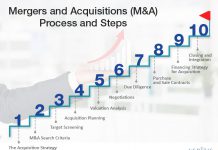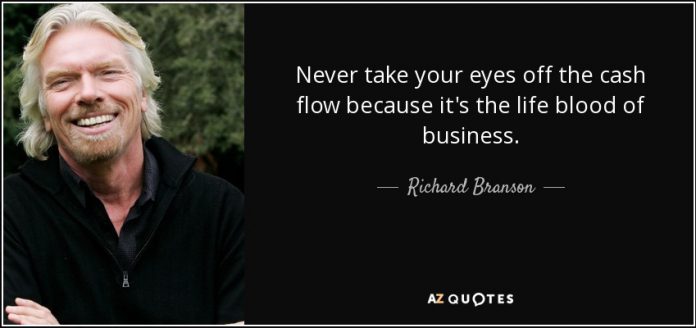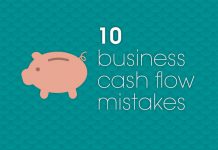Never take your eyes off cash flow, because it’s the life blood of business
When it comes to the financial management of any business, its often said that Cash Is King!
Whether your business is growing or struggling, managing your cash flow effectively is absolutely essential, and for many, its the key to business survival. You’ve probably heard the statistic that over 60% of businesses that fair are still profitable, but just ran out of cash.
If you’ve used a lot of your working capital, you may come up against a cash crunch that prevents you from paying suppliers, buying materials and even paying salaries. The time delay between the time you have to pay your suppliers the time you receive money from your customers is the problem, and the solution is cash flow management.
That’s why it’s critical to maintain a level of working capital that allows you to make it through those crunch times and continue to operate the business. Simply put, cash flow management means delaying outlays of cash as long as possible while encouraging your customers to pay it as quickly as possible.
Before we delve into the strategies to improve & manage cash flow in your business, lets first look at the the basics of cash flow management.
Important Cash Flow Basics
So, what is cash flow? It’s basically the movement of funds in and out of your business. Typically, businesses track cash flow either weekly, monthly or quarterly. There are essentially two kinds of cash flows:
Positive cash flow: This occurs when the cash entering into your business from sales, accounts receivable, etc. is more than the amount of the cash leaving your businesses through accounts payable, monthly expenses, employee salaries, etc.
Negative cash flow: This occurs when your outflow of cash is greater than your incoming cash. This generally means trouble for a business, but there are steps you can take to fix the negative cash flow problem and get into positive zone. Cutting business expenses is one of the quick fix, we’ll discuss more strategies in detail soon.
These critical numbers tell you just how much is coming in and how much is going out of your business. Making more than you’re spending? It’s all good. Cash flow regularly edging into the negative zone? Not so good.
Profit Does Not Equal To Good Cash Flow
You can’t just look at your profit and loss statement (P&L) and get a grip on your cash flow. Many other financial figures feed into factoring your cash flow, including accounts receivable, inventory, accounts payable, capital expenditures, and taxation.
Effective cash-flow management requires a laser focus on each of these drivers of cash, in addition to your profit or loss. Rules of accounting define Profit simply as revenue minus expenses. However, a smart business owner understand the fact that whether you earned a profit is not the same as knowing what happened to your cash.
Find Out Your Breakeven Point
You should know when your business will become profitable, not because it will affect your cash flow — because it won’t — but because it gives you an early goal to strive for and a ready-made target for projecting future cash flow. Negative cash flow and negative profits make for a grim combination. Focus your efforts on managing your cash flow with an eye toward reaching that moment when you realize your first profits.
So, gather data about our income and expenses and start doing breakeven analysis.
You Can’t Control What You Don’t Measure
Finding out the amount of working capital a business needs to operate is the first step. You need to answer questions like:
- How much inventory do I need to hold?
- How many invoices are overdue?
- How much cash is tied up in work in progress?
- How long does it take from paying our suppliers for the materials to extracting cash from the customers?
Your bookkeeper, accountant, accounting software and even spreadsheets can help you anticipate inflows and outflows of money over a period of time. Its important to start measuring the key metrics now.
Also read – 6 Important metrics every business owner must track.
We’ve seen how you can quickly fix your cash flow problems using the tips mentioned at this article: Effective Cash Flow Management Strategies
However, its important to continuously maintain a healthy cash flow in your business or startup. Lets see how you can do this:
1) Identify Business Risks & Prepare In Advance
There are many risks involved in running a business, and serious challenges should be expected at some point in the future. You need to consider a number of scenarios such as “What if that big order suddenly comes in?”; “What if a big order is cancelled?” or “What if that important client goes missing while still owing me money?” This kind of risk analysis can become part of your cash-flow budgeting process.
Try this simple method – If you’re using a spreadsheet to enter cash inflows, simply reflect a hypothetical situation by adding or deleting inflows. The repercussions in the following weeks and months should immediately be visible, so you can consider what you would do if the event occurred. Here is an excel template for managing cash flow in case you need one.
Non paying client is just one of the possible threats. There are many more such aspects that you should account for while making cash flow forcasting.
This guide might help you get started – How to future proof your business.
2) Create A Separate Bank Account For Your Business
A common mistake associated with running a business – especially among start-ups – is mixing business and personal bank accounts and credit cards. Since initial financing often comes from the owner’s personal savings, it’s easy to see how that can happen.
Its strongly advised to have a separate bank account for your business. You can ask your bank to issue a credit card, make business-related purchases on that card and pay using your company account. Most credit cards provide management reports that detail the types of purchases made over the month and over the past year. This type of information can then be used in your cash flow budget for the next year.
Our accounting software, ProfitBooks allows to import bank statements for reconciliation. This saves a lot of time and eliminates human errors.
3) Monitor Your Inventory Efficiently
Analyze inventory movement to determine which items are selling and which ones are duds that soak up your working capital. Try to keep inventory levels lean so that your working capital isn’t tied-up unproductively and unprofitably.
Here is a guide to efficient inventory management techniques.
4) Always Keep Buffer Money
Once you find out the breakeven point as discussed earlier, you must ensure your business has enough cash to fund your working capital needs. Its advised to keep three months worth of outgoings in the bank for a rainy day. That may be a thing of the past, but if that’s the case with you, make sure you have a buffer of some sort, either personal funds available or an overdraft or revolving credit facility.
5) Implement Better System To Manage Cash Flow
Many businessmen procrastinate to invoice customers. Some do not invoice as soon as they deliver the product or services or do it just at the month end. Many do not even know how much is owed to them by their customers or how much they owe to suppliers.
If you are one of them, its time to start implementing an efficient process to manage cash flow. You can use a simple spreadsheet or an accounting software. But its important to have some system in place.
6) Cut Costs, Control Cash Outflows
Best way to control cash flow is to stay on top of your expenses. When we start making profits, we often tend to ignore the cost cutting opportunities. Unmanaged outflow could be a silent business killer.
Here are 30 ideas to save money and survive cash flow crunch.
7) Keep Your Cash Growing
Keep your cash balances in interest-earning accounts, which are available at most banks. In some cases, you might encounter a minimum balance requirement. However, since interest rates on these accounts are often lower than those of savings accounts, certificates of deposit (CDs), or money market accounts, consider keeping the bulk of your funds in higher-paying accounts, then transferring funds to meet the minimum balance requirement in your interest-bearing checking account (plus the total payments due that week or month).
Avoid long-term certificates of deposit, which lock you in for a specific period of time, since redeeming them early may cost you interest. Either invest in penalty-free certificates or that portion of funds which you are not likely to need during the life of the CD.
8) Do not focus on profit, focus on cashflow
Agnes Cserhati of AC Power coaching estimates that 90% of the SMEs she works with do not have a cash flow plan from day one, despite having forecasts of profit margins for years ahead. She says this is a common reason for early business failure.
“If your cashflow is in order, your profit will be in order,” she says. “A lot of businesses do not make it past six months. They might have been a profitable business eventually, but they need to have good cash flow to survive.”
She also encourages young businesses to work with reliable, quick-paying clients initially, even if it means smaller clients and slimmer profits margins.
Final Thoughts
Small business owners usually learn one principle early in the life – “Cash is king”. Building and keeping an adequate stockpile of cash provides maximum opportunity and flexibility to any business while enabling its owners to sleep soundly at night.
Without cash, profits are meaningless. Many a profitable business on paper has ended up in bankruptcy because the amount of cash coming in doesn’t compare with the amount of cash going out.
Firms that don’t exercise good cash management may not be able to make the investments needed to compete, or they may have to pay more to borrow money to function.
Have you suffered cash flow problems? How did you resolve the deficit? Please share your experience in the comments section below.
7 Steps To A Healthy Cash Flow With Denyse Whillier Webinar Recording



















